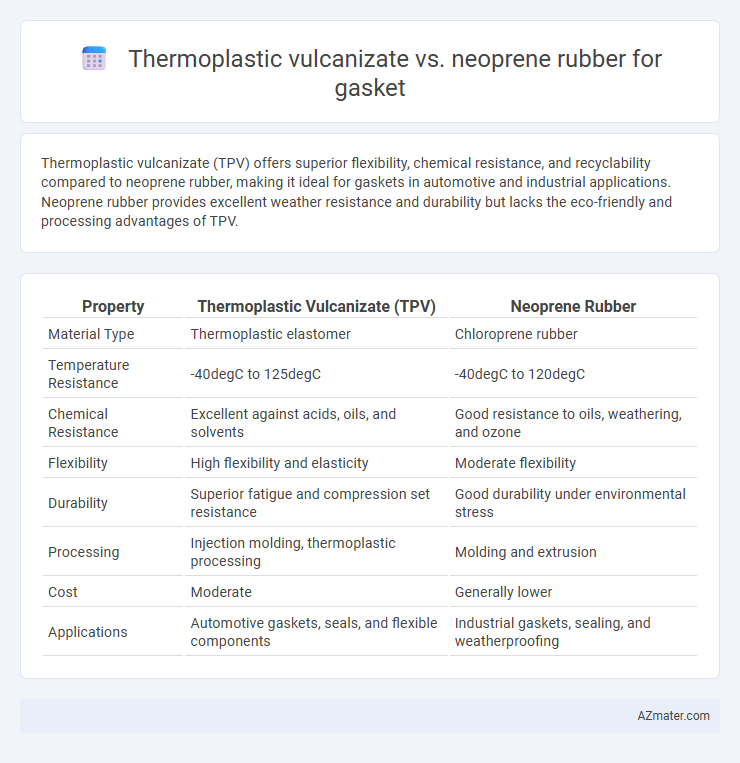Thermoplastic vulcanizate (TPV) offers superior flexibility, chemical resistance, and recyclability compared to neoprene rubber, making it ideal for gaskets in automotive and industrial applications. Neoprene rubber provides excellent weather resistance and durability but lacks the eco-friendly and processing advantages of TPV.
Table of Comparison
| Property | Thermoplastic Vulcanizate (TPV) | Neoprene Rubber |
|---|---|---|
| Material Type | Thermoplastic elastomer | Chloroprene rubber |
| Temperature Resistance | -40degC to 125degC | -40degC to 120degC |
| Chemical Resistance | Excellent against acids, oils, and solvents | Good resistance to oils, weathering, and ozone |
| Flexibility | High flexibility and elasticity | Moderate flexibility |
| Durability | Superior fatigue and compression set resistance | Good durability under environmental stress |
| Processing | Injection molding, thermoplastic processing | Molding and extrusion |
| Cost | Moderate | Generally lower |
| Applications | Automotive gaskets, seals, and flexible components | Industrial gaskets, sealing, and weatherproofing |
Introduction to Thermoplastic Vulcanizate and Neoprene Rubber
Thermoplastic vulcanizate (TPV) combines the elasticity of vulcanized rubber with the recyclability and processability of thermoplastics, making it ideal for gaskets requiring flexibility and chemical resistance. Neoprene rubber, a synthetic rubber known for its excellent resistance to oils, heat, and weathering, is widely used in gasket applications where durability and environmental resistance are critical. Both materials offer unique advantages, with TPV providing superior flexibility and recyclability, while neoprene delivers strong resistance to harsh chemicals and physical wear.
Chemical Composition and Structure Comparison
Thermoplastic vulcanizates (TPVs) combine a cross-linked rubber phase dispersed within a thermoplastic matrix, typically consisting of vulcanized ethylene-propylene rubber (EPR) embedded in polypropylene, offering enhanced flexibility and thermal stability. Neoprene rubber, a chloroprene-based synthetic rubber, features a covalently cross-linked polymer network known for its resistance to oil, chemicals, and weathering due to the presence of chlorine in its backbone. TPVs provide a balance of thermoplastic processability and elastomeric properties derived from their dual-phase morphology, whereas Neoprene's homogenous elastomeric structure delivers robust chemical resistance and durability in gasket applications.
Mechanical and Physical Properties
Thermoplastic vulcanizate (TPV) offers superior flexibility, excellent resistance to compression set, and enhanced weathering durability compared to neoprene rubber, making it ideal for gaskets requiring long-term sealing performance. Neoprene rubber exhibits higher tensile strength and better resistance to oils and chemicals but tends to have lower elongation at break and can harden under prolonged exposure to heat. The choice between TPV and neoprene depends on the specific mechanical demands and environmental conditions, with TPV favored for dynamic sealing and neoprene for chemical resilience.
Temperature and Weather Resistance
Thermoplastic vulcanizate (TPV) offers excellent weather resistance and performs well in temperature ranges from -50degC to 150degC, making it suitable for applications exposed to UV radiation, ozone, and moisture. Neoprene rubber provides superior resistance to ozone, weathering, and aging, with a temperature tolerance typically between -40degC and 120degC, often preferred in outdoor and industrial gasket applications. TPV's higher temperature range and enhanced flexibility under varying weather conditions give it an edge in dynamic environments requiring durable sealing materials.
Chemical Resistance and Compatibility
Thermoplastic vulcanizate (TPV) offers superior chemical resistance against acids, alkalis, and oils, making it highly compatible with aggressive environments encountered in industrial gasket applications. Neoprene rubber exhibits moderate chemical resistance, performing well with refrigerants, light oils, and certain solvents but is less effective against strong acids and organic solvents. Selecting TPV ensures enhanced durability and longevity of gaskets exposed to harsh chemicals, while neoprene remains suitable for applications with milder chemical exposure.
Flexibility and Compression Set Performance
Thermoplastic vulcanizates (TPVs) exhibit superior flexibility compared to neoprene rubber, making them ideal for gaskets requiring extensive movement and dynamic sealing applications. TPVs also offer a lower compression set, maintaining resilience and sealing integrity over prolonged periods under compressive stress, whereas neoprene tends to exhibit higher permanent deformation. The enhanced flexibility and excellent compression set performance of TPVs contribute to longer service life and improved sealing reliability in industrial gasket applications.
Manufacturing and Processing Differences
Thermoplastic vulcanizate (TPV) gaskets benefit from faster manufacturing cycles due to their ability to be processed using conventional thermoplastic methods like injection molding, enabling high-volume production with consistent precision. Neoprene rubber gaskets require vulcanization during curing, a time-intensive process involving heat and pressure that limits rapid production and necessitates specialized rubber molding equipment. TPVs offer easier recyclability and post-processing modifications compared to neoprene, whose cross-linked structure restricts reshaping and results in longer lead times for finishing and assembly.
Cost-Effectiveness and Economic Factors
Thermoplastic vulcanizate (TPV) offers superior cost-effectiveness compared to Neoprene rubber due to its lower processing costs and recyclability, which reduce material waste and overall expenses. TPV's ability to be molded repeatedly enables efficient production cycles, making it economically favorable in high-volume gasket manufacturing. In contrast, Neoprene rubber entails higher raw material costs and longer curing times, increasing labor and operational expenses in gasket applications.
Common Applications in Gasket Manufacturing
Thermoplastic vulcanizate (TPV) is commonly used in gasket manufacturing for automotive, electrical, and industrial sealing applications due to its excellent chemical resistance, flexibility, and temperature range (-40degC to 135degC). Neoprene rubber gaskets are preferred in HVAC systems, refrigeration, and marine environments because of their superior resistance to ozone, weathering, and moderate oil exposure, with typical operating temperatures between -40degC to 120degC. Both materials provide reliable sealing solutions, but TPV offers enhanced reprocessability and environmental benefits, while neoprene excels in durability against harsh outdoor and oil-based conditions.
Which Material is Best for Your Gasket Needs?
Thermoplastic vulcanizate (TPV) offers superior flexibility, chemical resistance, and ease of processing, making it ideal for gaskets exposed to dynamic environments and frequent temperature fluctuations. Neoprene rubber excels in ozone resistance, durability, and moderate oil resistance, suitable for applications requiring robust physical strength and weather resistance. The best material depends on your gasket's specific exposure to chemicals, temperature ranges, and mechanical stress, with TPV preferred for versatile, high-performance sealing and Neoprene chosen for rugged, outdoor conditions.

Infographic: Thermoplastic vulcanizate vs Neoprene rubber for Gasket
 azmater.com
azmater.com